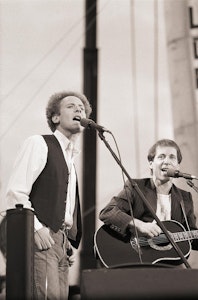This article is taken from the April 2025 issue of The Critic. To get the full magazine why not subscribe? Right now we’re offering five issues for just £10.
Even the top pop stars of the 1960s didn’t expect long shelf lives. “If you have five years, that’s extraordinary,” a 27-year-old Paul Simon told the Los Angeles Times in 1968, when his name was inseparable from that of his singing foil and fellow New Yorker, Art Garfunkel.
But as a solo artist of 83 he’s still making fine records and playing to packed houses, having picked up 16 Grammy awards, a couple of inductions into the Rock and Roll Hall of Fame, a ranking of eighth in Rolling Stone’s “100 Greatest Songwriters of All Time” and, doubtless to his own well-developed sense of amusement, 246th place in its list of greatest-ever guitarists.
His success is based on a portfolio of songs, universal without being impersonal, about the ways in which people navigate their lives — whether in pain or hope, together or apart, and occasionally all of these at the same time.
Many of his standards postdate the Simon and Garfunkel period (“Still Crazy After All These Years”, “Fifty Ways to Leave your Lover”, “You Can Call Me Al”, “Me and Julio Down by the Schoolyard”, to name but four). Further classics appear on albums such as Graceland (1986) and The Rhythm of the Saints (1990), the euphoric South African and Brazilian accents of which did so much to help put “world music” on the map.
For half a century, Simon and Garfunkel has been history
Rather less well-known is his short Vietnam War ballad, “Soft Parachutes”. Featuring just his acoustic guitar and husky tenor voice, it cropped up in an odd little art movie called One-Trick Pony (1980). Simon both wrote and starred in this tale of a fictional 70s band whose leader had a big hit back in the 60s — “Soft Parachutes” — then never quite came out from under its shadow.
It’s interesting that ten years into his own stellar solo career, Simon chose to write about a double-edged 1960s legacy. Interesting too that a much later film, In Restless Dreams (2024), about the making of his most recent album Seven Psalms, included extended flashbacks to the 60s, when he was still one part of a two-man band.
The history of popular song is littered with legendary binaries: Rodgers and Hammerstein, The Carpenters, Paul McCartney and The Frog Chorus. Simon and Garfunkel will forever be up there with the best of them. Their studio recording career ran from only 1965 to 1970 — slightly longer if you toss in 1957’s “Hey Schoolgirl”, credited to Tom and Jerry in an era when their real names sounded “too ethnic” (and well into the 60s they still had to resist record-company pressure to call themselves The Rye Catchers). But boy, did they strike while the iron was hot.

Moving on from highly melodic, lyrically intricate folk-rock origins, they staked out a musical territory entirely their own. “The Sound of Silence”, “Homeward Bound”, “America”, “Mrs Robinson”, “The Boxer” and “Bridge Over Troubled Water” have continued to resonate worldwide, not just since the 1960s but almost as if from long before that time. The hymnal harmonies on songs like “Scarborough Fair/Canticle” could be said to evoke George Herbert just as much as George Harrison.
Simon, an all-American boy with Ukrainian and Lithuanian roots, wrote nigh on everything the pair recorded. He mostly sang lead too, quite consummately. Even his own mother, however, had to acknowledge that the more extraordinary pipes belonged to his harmoniser, heard to the most sublime effect on Artie’s delivery of “Bridge Over Troubled Water”.
But soon after that song and its eponymous album shot them to a critical and commercial zenith, Simon broke up the band. And despite concert reunions and occasional tours to meet an apparently insatiable demand from the fanbase, only one new tune — 1975’s “My Little Town” — has been released since. So, for half a century now, this duo has been history.
Yet their magical half-decade has never stopped haunting its dominant partner. A random online stab, for instance, shows that Gold Derby’s “Ten Best Paul Simon Songs Ranked” includes six of his aforementioned 1960s gems, alongside just four from the 14 later solo albums.

The number of those who still can’t grasp why Garfunkel had to be left behind may be matched by those who struggle to nail down his exact contribution to the old alchemy. Simon’s own explanations don’t shed much light. “I think, in a certain way, he improves my records,” he said in 1983. “He makes the sound of them more agreeable to many, many people. But I don’t care …”
Aspects of Garfunkel’s personality clearly grated on him. The taller partner’s tendency to say in public things like “My best friend in life was my voice and we went everywhere together” probably didn’t help. For his part Simon, whose existential angst may at times have turned “Hello darkness, my old friend” into a default greeting, can’t have been the easiest company.
But ever since 1970 it’s more of their symphonic blend that millions have craved. More stone-cold classics from a team never seen to be “cool” like Bob Dylan, although perhaps their readier accessibility in fact made them more representative of the 1960s cultural moment.

For what it’s worth, I’m personally not in the “No Artie, No Party” lobby, loving much of Simon’s solo work too — the firmer parachutes as well as the soft. Whenever he sings or speaks, the world seems more still and clear under his attention. Tormented by being only 5’ 3” tall (his second wife, similarly short, would say to him, “Don’t stand next to me at the party — people will think we’re salt and pepper shakers”), on record he can be any height he likes: “Everybody loves the sound of a train in the distance / Everybody thinks it’s true.”
Even so, there’s a definite trace of Lost Eden about 1968’s “America”, with its fragmented images and oblique rhymes (though Simon had few pretensions there — “people who call you a poet are people who never read poetry”). Those particular lyrics, set against such unexpected musical progressions, seem to be expanding the very idea of what a song can be.
And take a look on YouTube at the 1981 Central Park reunion-concert version of Simon’s already majestic solo anthem “American Tune”. Somehow Garfunkel’s stage presence — visual, vocal, interactive — briefly makes any notion of Simon standing alone seem unnatural.

Simon himself has often appeared to have at least one, arguably fallible, eye on the longer term. “It is discomforting, almost painful to look back on something someone else has created and realize that someone else was you,” he once wrote on an album’s sleeve notes. He was just 23 at the time, describing a batch of songs that included “The Sound of Silence”.
As a singer-songwriter — and in some parallel universe there’s a pithier term for that job description — it’s easy to say Paul Simon peaked early. I prefer to think that in his twenties he attained a dizzying height, which turned out to be a dizzying plateau. And ultimately I guess, as Mozart might attest, there are worse things than being haunted through six decades by the fact that you weren’t yet 30 years old when you came up with “Bridge Over Troubled Water”.







